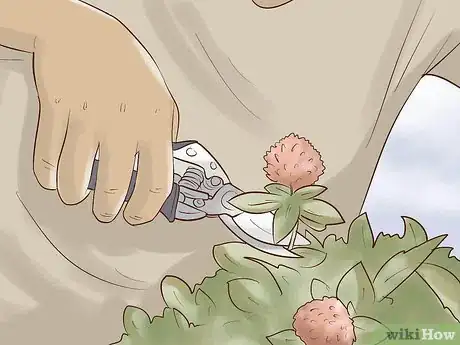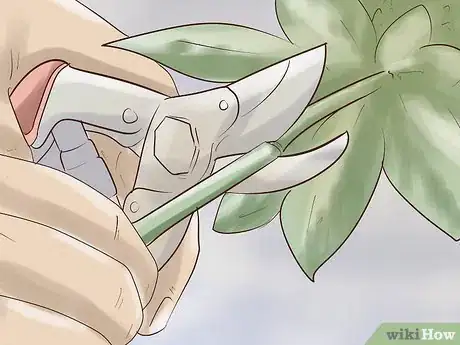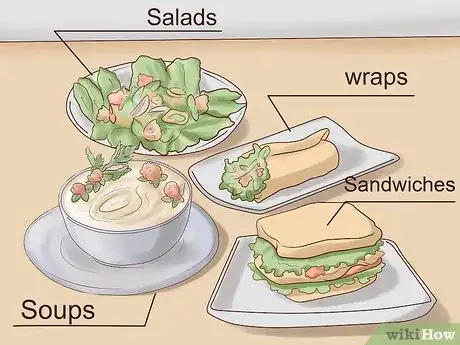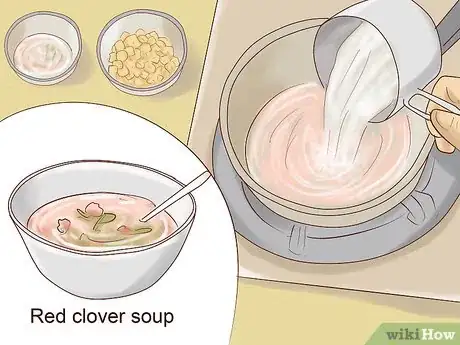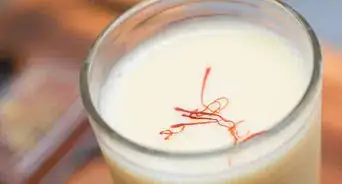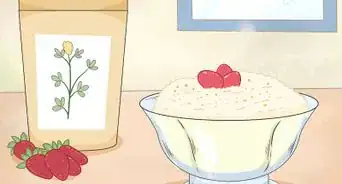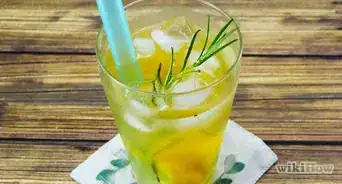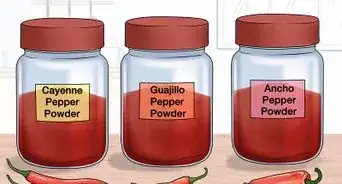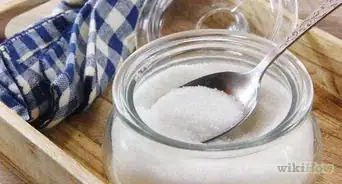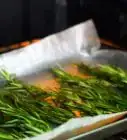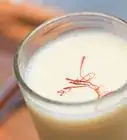This article was co-authored by wikiHow Staff. Our trained team of editors and researchers validate articles for accuracy and comprehensiveness. wikiHow's Content Management Team carefully monitors the work from our editorial staff to ensure that each article is backed by trusted research and meets our high quality standards.
This article has been viewed 24,556 times.
Learn more...
Red clover is a common flowering plant in many parts of the world. While most people think of it as pretty plant or even as a weed, it has many uses for human consumption. Not only can red clover be eaten raw, but it can be cooked and used in a variety of dishes. By learning how to prepare it and picking specific recipes, you’ll find new ways to incorporate red clover into your diet.
Steps
Preparing Red Clover
-
1Cut red clover. Cut red clover leaves or flowers early in the day before the plant's mid-bloom. Mid-bloom is when half of the plants in a location are blooming. Make sure to cut flowers above the leaf growth and cut leaves in clumps of three.
- Avoid discolored leaves or flowers, as the plant could be sickly and have an odd taste.
-
2Rinse the leaves and flowers. Place the leaves and flowers in a colander and rinse them with cool water. Make sure you rinse off any dirt or any debris. Pay special attention to the flowers, as they might contain dirt or bugs.
- Spread your leaves and flowers in one layer on a clean paper towel.
- Allow the leaves and flowers several hours to dry.
- Gently pat the leaves and flowers with a cloth towel if you want them to dry quicker.
Advertisement -
3Remove stems with a scissor or pruning shear. Whichever part of the red clover plant you decide to eat – whether it be the leaves or the flowers – you’ll need to remove them from the stem. While the stem contains fiber, it is not as nutritious as the leaves or flowers and should not be consumed. In addition, it does not taste very good.
-
4Eat red clover uncooked. As an edible flowering plant, you can choose to eat red clover flowers or leaves uncooked. The plant’s natural sweetness will complement a wide variety of dishes. Consider adding red clover flowers or leaves to:
- Salads
- Soups
- Sandwiches and wraps[1]
-
5Steam the leaves and/or flowers. Place clover leaves or flowers in a medium saucepan. Cover the bottom with a quarter inch of water. Put the heat on low, and allow the clover to steam.[2]
- Add steamed red clover to spinach or other leafy green side dishes.
- Steam a small amount of red clover leaves to serve with a side of fish or chicken.
- Consider steaming red clover flowers or leaves and adding them to a stew or soup.
-
6Use red clover as a garnish. Red clover leaves and flowers make a great garnish for just about anything. This is because the sweet fresh flavor of the uncooked leaves compliment many other flavors. Consider:
- Sprinkling red clover flower over ice cream or other deserts.
- Garnishing chicken or fish dishes with red clover leaves.[3]
-
7Ground red clover flowers into a baking flour. You can also dry and ground red clover flowers into a fine powder/flour to be used to prepare baked goods. Red clover flour is very popular for desserts, due to its sweet aftertaste. Like other flowering plants, the process is somewhat simple.
- Place the flowers on an elevated rack and place them in a cool and dry location for several days. If you want them dry quicker, you can place them in a dehydrator. They are dry when they are crisp and crumble to the touch.
- Ground the flowers with a mortar and pestle or similar device. Make sure that you turn the flowers into a very fine powder.
- Once you have a fine powder, incorporate the flour into an existing recipe of your choice. Feel free to substitute an equivalent amount of red clover flour for all-purpose flower.[4]
Picking a Specific Recipe
-
1Create red clover syrup. Combine 4 cups (.94 l) of fresh red clover flowers and 4 cups (.94 l) of water in a pot and allow them to simmer for 20 minutes. Take your pot off the heat and allow it to sit overnight. In the morning, strain the liquid and add 4 cups (.94 l) of sugar and ½ of a sliced orange. Allow the mixture to sit on low heat for several hours until it becomes thick and syrup-like.
- You can substitute orange for a lemon, if you want. In addition, you can leave citrus out entirely.
- Feel free to increase the recipe proportionally.
-
2Brew a red clover tea. Boil 4 cups of water (.95 l) in a medium saucepan and then remove it from the heat. Add 1 cup (.24 l) of red clover flowers (dried or fresh) and 2 tablespoons of mint (30 ml). Allow the flowers and mint to steep for 10 minutes. Pour the liquid into a tea or flour strainer, and strain the mixture into a mug or another pot.
- Feel free to add honey or lemon before drinking.
- Make sure you wash the clover flowers thoroughly before you boil them.[5]
-
3Prepare a red clover soup. Sautee 2 cups (.48 l) of fresh red clover flowers with a tablespoon (30 ml) of butter until they are golden brown. Add 1 cup (24 l) of cubed potatoes, 1/4 cup (60 ml) of tahini, and 1 cup (24 l) of water. Allow the mixture to simmer for 40 minutes.
- Add spices to taste. Some spices to consider include parsley, sage, and rosemary. Also, consider adding pennycress leaves and/or seedpods.
- Alternatively, instead of sautéing, you can run the mixture through a food processor before simmering it for 40 minutes.[6]
-
4Consume red clover as part of a cleanse. Red clover is valued for its cleansing properties of the human body, especially its ability to help cleanse the spleen of dead red blood cells. If you want to use red clover as part of a cleanse, consider incorporating red clover into your cleanse routine.
- Make red clover tea.
- Consider adding red clover flowers to smoothies.
- Cook a red clover flower soup.
Community Q&A
-
QuestionCan I soak the leaves in my drinking water and get some benefit?
 Community AnswerThat is referred to as infused water, and yes, it has flavor and health benefits.
Community AnswerThat is referred to as infused water, and yes, it has flavor and health benefits.
References
- ↑ https://www.organicfacts.net/health-benefits/herbs-and-spices/red-clover.html
- ↑ http://www.bio.brandeis.edu/fieldbio/Edible_plants/RedClover/RedClover.html
- ↑ https://whatscookingamerica.net/EdibleFlowers/EdibleFlowersMain.htm
- ↑ http://www.bio.brandeis.edu/fieldbio/Edible_plants/RedClover/RedClover.html
- ↑ http://www.food.com/recipe/red-clover-tea-127541#activity-feed
- ↑ https://wildfoodgirl.com/2010/weird-clover-flower-soup/
